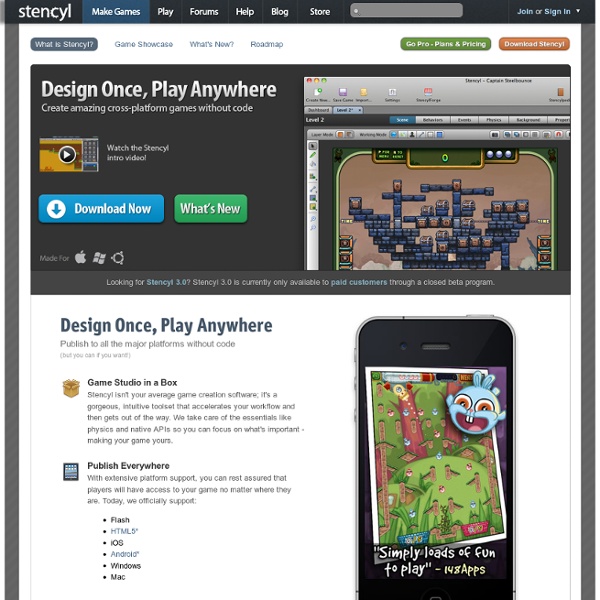Make iOS, Android and Flash Games with Stencyl
Build Worlds If you're used to graphics editors like Photoshop, you'll feel right at home in the Scene Designer. Familiar features, such as a selection tool, zooming, grid-snapping and flood fill, will help you quickly craft complex worlds out of Actors, Tiles and Terrain. Create Actors Drop in graphics from your computer to create Actors on the fly. Browse Game Assets When it comes to game development, most of us aren't Jacks of all trades.
Code Monster from Crunchzilla
<h2>Code Monster gets kids excited about programming. It is a combination of a game and tutorial where kids experiment with learning to code. <p> Code Monster use Javascript. I'm Code Monster! Getting Started Lesson 1 BACK How to Play | Lesson Sections | About | FAQ | Terms of Use | Privacy | Contact | © 2015 How to Play Code Monster teaches kids and adults a little about Javascript programming! It's easy to play. Click on the Reset button if you really mess up your code and want to start over on a lesson. Code Monster saves what lesson you are on, so feel free to stop at any time and come back later. Have fun! About Code Monster from Crunchzilla is an interactive tutorial for kids that focuses on action. Projects start with simple boxes and colors, rapidly progressing into exciting experiments with simple animation and fractals. Code Monster is a gentle and fun introduction to programming concepts. Code Monster is based in Seattle, WA. Frequently Asked Questions Sure! Terms of Use Oh my.
Hopscotch
Cargo-Bot
Gamestar Mechanic
Waterbear: Welcome
playforce.org - Playforce: Learning from the games we play
Welcome to Jeroo!
Jeroo is an effective, award winning, classroom-tested tool that helps novices learn fundamental concepts of object-oriented programming, including Instantiating and using objects Writing methods to extend behavior Selecting and using fundamental control structures Jeroo engages students with Story telling Animated execution Simultaneous code highlighting Current Version – 2.4 (Released August 2012) The new version now allows for the window to be dynamically resized, enabling you to have a much larger code editing window—helpful for those long programs and for presentation using large font sizes. See the download page to get a copy today. Awards Jeroo was recipient of the 2004 Premier Award for Excellence in Engineering Education Courseware, sponsored by NEEDS.
Atlantis Remixed
Transformational play involves the use of virtual worlds to help people learn and grow in a context where they can fail safely. Theory At its core, transformational play is a learning and empowerment philosophy that is grounded in the belief that each one of us is capable of, wants to, and deserves to achieve, great things. Unlike any other form of curriculum, these games offer entire worlds in which learners are central, important participants; a place where the actions of a ten-year old can have significant impact on the world; and a place in which what you know is directly related to what you are able to do and, ultimately, who you become. The theory highlights relations among the three interconnected elements of person with intentionality, content with legitimacy, and context with consequentiality. Research Manuscript (PDF) Teacher Manuscript (PDF) Engine Key features of the 3D engine include: Key features of the facilitator dashboard include: Key Game Mechanics: Projects The Doctors Cure
Raspberry Pi: Baking Pi – Operating Systems Development
This course has not yet been updated to work with the Raspberry Pi models B+ and A+. Some elements may not work, in particular the first few lessons about the LED. It has also not been updated for Raspberry Pi v2. Welcome to Baking Pi: Operating Systems Development! You can now help contribute to this tutorial on GitHub. This website is here to guide you through the process of developing very basic operating systems on the Raspberry Pi! This course takes you through the basics of operating systems development in assembly code. Rather than leading the reader through the full details of creating an Operating System, these tutorials focus on achieving a few common tasks separately. 1 Requirements 1.1 Hardware In order to complete this course you will need a Raspberry Pi with an SD card and power supply. 1.2 Software In terms of software, you require a GNU compiler toolchain that targets ARMv6 processors. 2 Lessons
Related:
Related:



